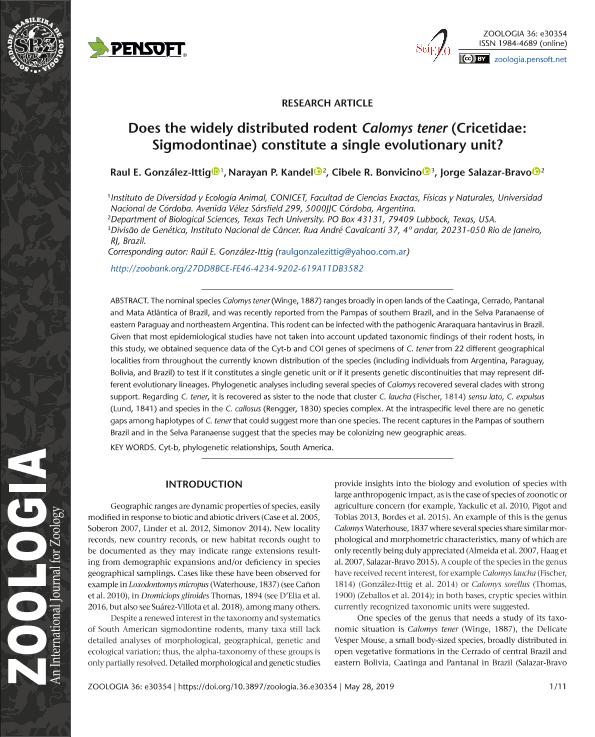Artículo
Does the widely distributed rodent Calomys tener (Cricetidae: Sigmodontinae) constitute a single evolutionary unit?
Fecha de publicación:
28/05/2019
Editorial:
Sociedade Brasileira de Zoologia
Revista:
Zoologia (Curitiba)
ISSN:
1984-4670
e-ISSN:
1984-4689
Idioma:
Inglés
Tipo de recurso:
Artículo publicado
Clasificación temática:
Resumen
The nominal species Calomys tener (Winge, 1887) ranges broadly in open lands of the Caatinga, Cerrado, Pantanal and Mata Atlântica of Brazil, and was recently reported from the Pampas of southern Brazil, and in the Selva Paranaense of eastern Paraguay and northeastern Argentina. This rodent can be infected with the pathogenic Araraquara hantavirus in Brazil. Given that most epidemiological studies have not taken into account updated taxonomic findings of their rodent hosts, in this study, we obtained sequence data of the Cyt-b and COI genes of specimens of C. tener from 22 different geographical localities from throughout the currently known distribution of the species (including individuals from Argentina, Paraguay, Bolivia, and Brazil) to test if it constitutes a single genetic unit or if it presents genetic discontinuities that may represent different evolutionary lineages. Phylogenetic analyses including several species of Calomys recovered several clades with strong support. Regarding C. tener, it is recovered as sister to the node that cluster C. laucha (Fischer, 1814) sensu lato, C. expulsus (Lund, 1841) and species in the C. callosus (Rengger, 1830) species complex. At the intraspecific level there are no genetic gaps among haplotypes of C. tener that could suggest more than one species. The recent captures in the Pampas of southern Brazil and in the Selva Paranaense suggest that the species may be colonizing new geographic areas.
Palabras clave:
CYT-B
,
PHYLOGENETIC RELATIONSHIPS
,
SOUTH AMERICA
Archivos asociados
Licencia
Identificadores
Colecciones
Articulos(IDEA)
Articulos de INSTITUTO DE DIVERSIDAD Y ECOLOGIA ANIMAL
Articulos de INSTITUTO DE DIVERSIDAD Y ECOLOGIA ANIMAL
Citación
González Ittig, Raúl Enrique; Kandel, Narayan P.; Bonvicino, Cibele R.; Salazar-Bravo, Jorge; Does the widely distributed rodent Calomys tener (Cricetidae: Sigmodontinae) constitute a single evolutionary unit?; Sociedade Brasileira de Zoologia; Zoologia (Curitiba); 36; 28-5-2019; 333-344
Compartir
Altmétricas




